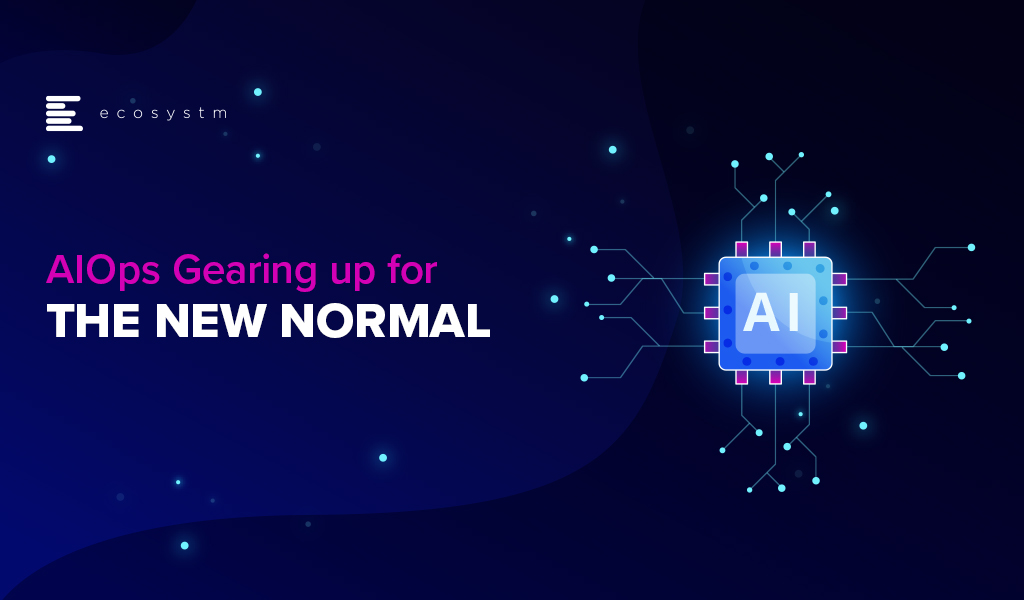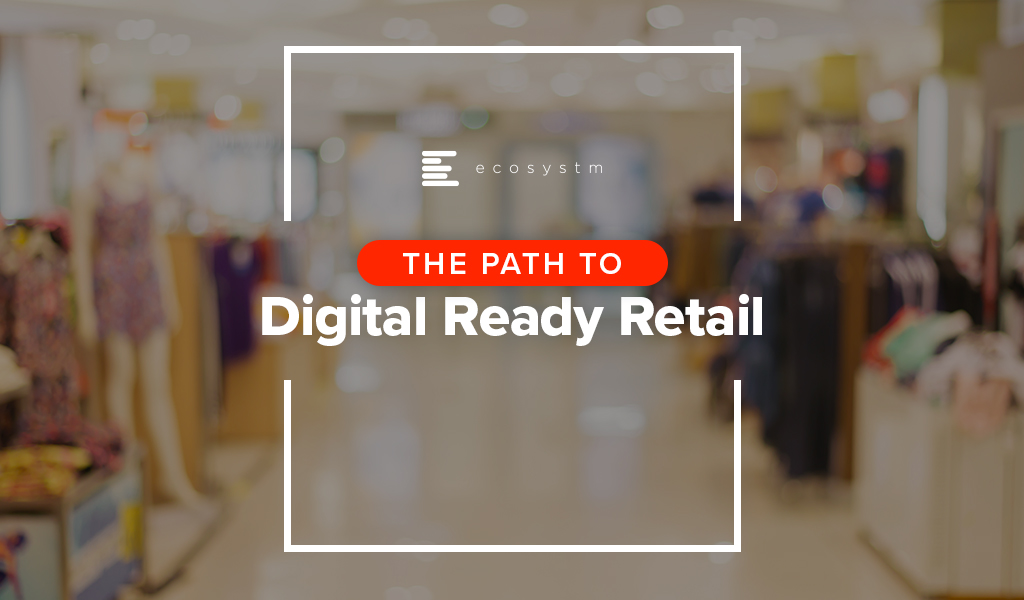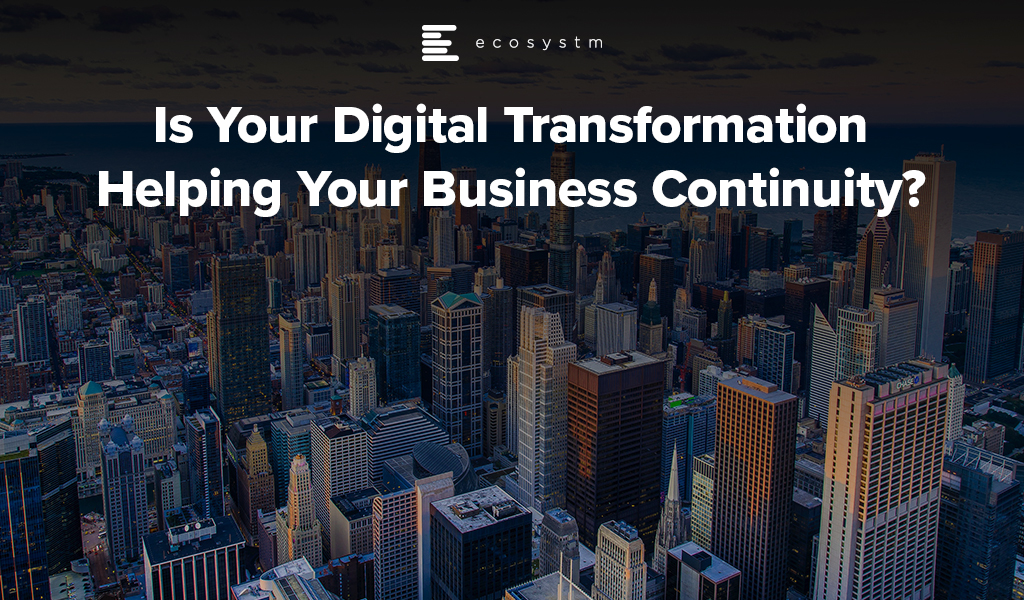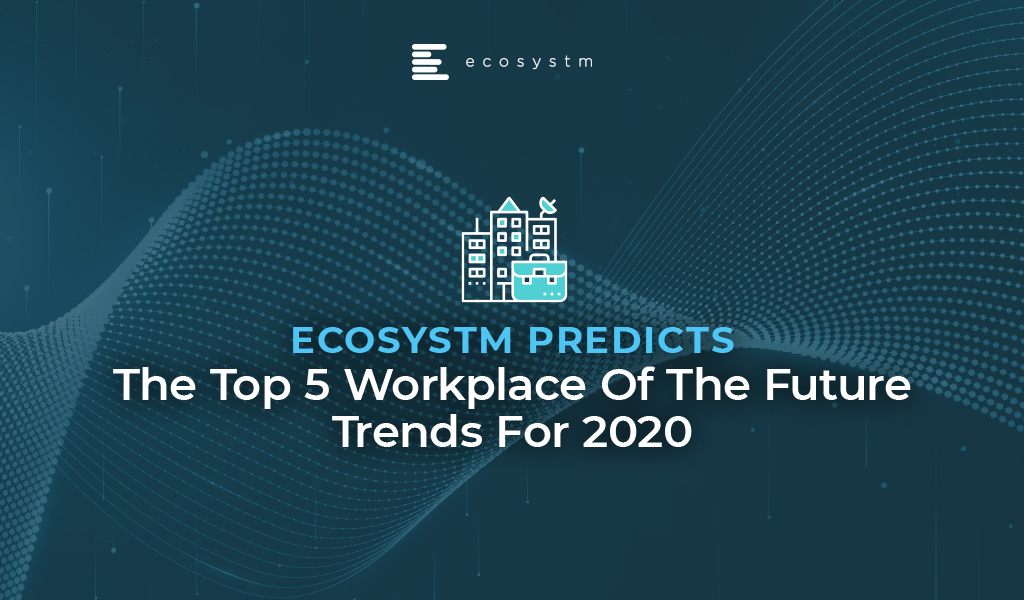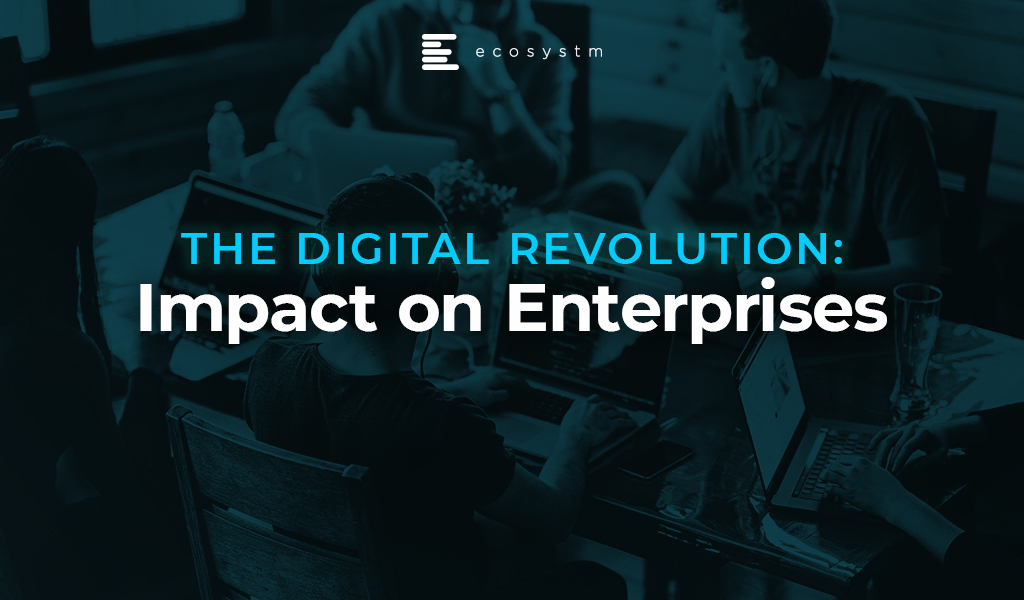The Retail industry has been one of the hardest-hit industries during the COVID-19 crisis. The industry had to pivot faster than many to cater to an evolving market need and customer expectation, amidst social distancing measures and supply chain disruption. Ecosystm’s Digital Priorities in the New Normal study finds that nearly 83% of organisations in Asia Pacific’s Retail industries were forced to work on digital transformation (DX) in the aftermath of the crisis (Figure 1).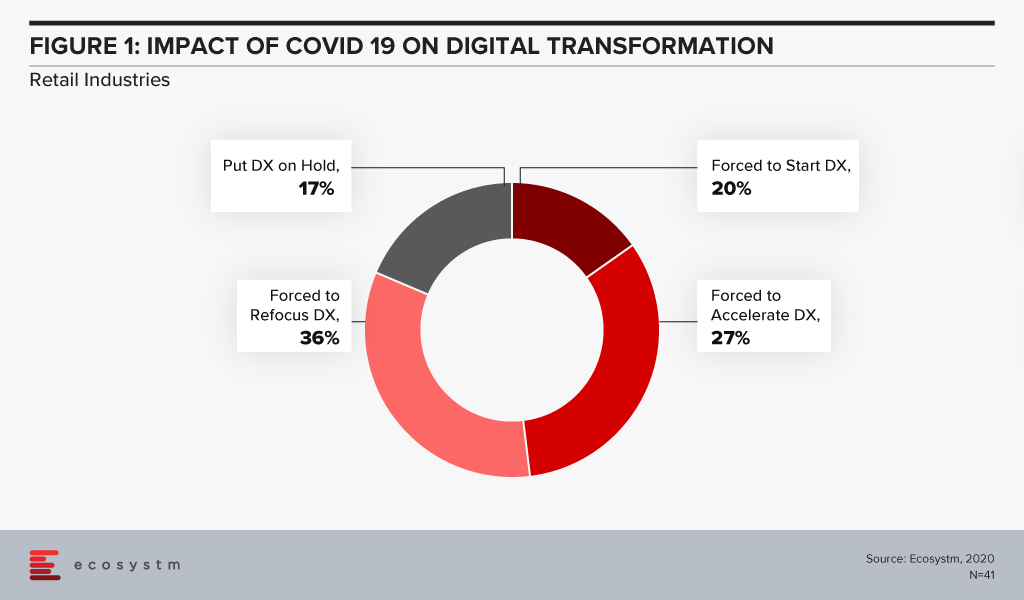
Retail organisations that had not walked the DX path found themselves struggling to cope in recent times. Ecosystm Principal Advisor, Alan Hesketh says, “Digital transformation in retail, as represented by deep customer understanding and omnichannel operations, is far from new. Industry leaders launched these activities almost 20 years ago and continue to aggressively develop these capabilities. Retailers not actively leveraging these capabilities to understand their customer preferences are at a massive competitive disadvantage.”
Anta Group Accelerates DX
The Anta Group, a sports products manufacturer based in China with over 12,500 stores, has launched a group-wide digital platform designed and deployed by IBM Services based on SAP S/4HANA. The initial phase of Anta Group’s DX included creating intelligent workflows and was completed in January 2020. This enabled the company to adjust its retail operations and switch to quickly to online channels during the COVID-19 pandemic.
Like any retail organisation, the Anta Group realised that their product offerings had to be diverse to cater to an evolving customer base. This growth required an upgrade to a group-level management platform to help the business run more efficiently across the entire value chain of procurement, supply, production and sales. The SAP S/4HANA platform gives the senior management a single view of data across business units to help with better decision making regarding production and sales optimisation. The company claims to have improved its supply chain efficiency by 80%, that has led to faster delivery and business growth even in these difficult times.
IBM Services has a role to play in providing the business intelligence required for agile decision-making. By integrating data from multiple sources – retail stores, multi-brand products, channels, customers, suppliers and finance teams – on the one platform can help Anta Group to settle accounts quickly and issue business analysis reports for different entities as well as a real-time view of the operation across the organisation.
Hesketh says, “Retailers must have an accurate, timely understanding of their customers’ behaviour and resulting sales performance. COVID-19 has dramatically increased the volatility of sales, making rapid recognition of changes essential. For those lagging in their digital transformation to acquire this understanding, an attractive option is partnering with organisations with demonstrated relevant capabilities; in this case with SAP, for the capabilities and performance of their in-memory product, and IBM for their configuration and implementation expertise.”
IBM and SAP evolving their partnership
In 2016, IBM and SAP had expressed intentions of increasing investments to help their customers on their DX journeys. As some economies move into the recovery phase, all businesses will be forced to transform – or keep transforming if they are already along that path. Last month saw IBM and SAP announce the evolution of their partnership with new offerings to help businesses transform faster. The next evolution of the IBM and SAP partnership aims to focus on faster DX time to value, innovation through industry-specific offerings, customer and employee experiences and providing flexibility and choice to organisations to run their workloads in hybrid cloud environments.
Hesketh adds, “But the product and implementation partners are, while important, not the real determinant of the success of DX activity and time to value. Retailers must recognise and commit to the strategic reshaping of their business, taking their large workforces with them on the journey. This is a high-risk change. A strong relationship between product vendor and implementation partner, as SAP and IBM demonstrate here, assists in reducing, not removing, this risk.”

Technologies to automate IT systems and relieve over-stretched IT operations teams have been moving into the mainstream over the last few years. Several factors, driven by the digital era, have made this necessary. Firstly, digital transformation is creating ever-larger IT environments and volumes of data that cannot be managed by manual processes. These distributed systems are also becoming more complex, incorporating IoT, mobile, multi-cloud, containers, and APIs. Moreover, for digital businesses, the financial impact of an outage makes time to resolution critical. Identifying and remediating issues before they affect the user is now paramount. AIOps provides intelligence to the IT operations team that allows them to proactively resolve events before they become outages.
Augmenting IT Operations with AIOps
AIOps allows IT operations teams to not only ensure observability of their systems and reduce noise but to also understand how events are interacting together to affect performance and take corrective action quickly. The primary features of AIOps are:
- Noise reduction. AIOps ingests systems data, surfaces priority anomalies and correlates them together. This brings the number of incidents to investigate back down to a human level. Rackspace recently announced that AIOps helped it reduce alert noise by 99% during the initial stage of its rollout. Successful vendor references typically cite similar figures between 95-99%.
- Root cause analysis. Once priority events have been correlated, AIOps identifies a root cause to enable the operations team to focus its efforts on a resolution. This is a task that proves challenging to perform at speed for a human operator considering the complexity of today’s systems.
- Proactive response. A range of responses is available with AIOps, from directing issues to the appropriate people, to recommending actions that can be taken by operators directly in a collaboration tool, to rules-based workflows performed automatically, such as spinning up additional AWS EC2 instances.
- Learning. By evaluating past failures and successes, AIOps can learn over time which events are likely to become critical and how to respond to them. This brings us closer to the dream of NoOps, where operations are completely automated.
The Impact of COVID-19 on IT Operations
The Ecosystm Digital Priorities in the New Normal study launched this month, asks technology users about how their digital priorities have shifted during the pandemic. Despite pressure to shift to digital delivery, almost 40% of participants reported that their organisations cut headcount in the IT department (Figure 1). Furthermore, over one third had been forced to cut their employees’ salaries. As we have seen in previous crises, IT operations teams are being asked to do more with less and will need automation to bridge the gaps.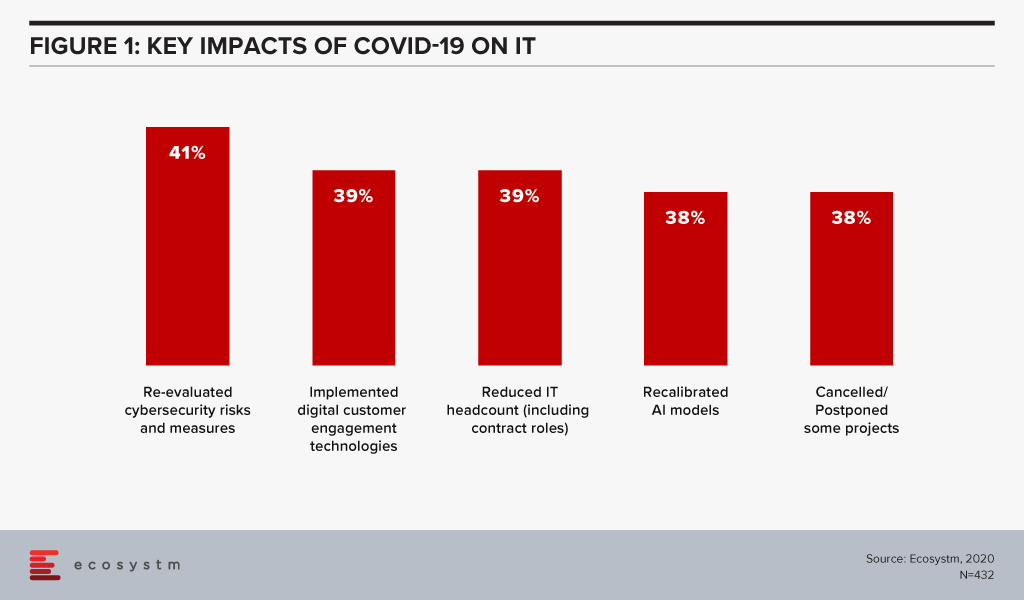
As we begin to move into the next phase of the COVID-19 reality and businesses continue to open, we will see many launch digital services that were conceived of during the crisis. One of the greatest challenges that IT departments face will be scalability as digital businesses grow. AIOps will be a go-to tool for IT operations to ensure uptime and improve user experience. It is likely that the next 12-18 months will be a watershed moment for AIOps.
NLP and the Democratisation of Data
Natural Language Processing (NLP) will be the next string in the bow of AIOps. While the ultimate goal of IT operations is to identify and remediate situations before they have an impact on the user, oftentimes it is the service desk that generates the initial barrage of alerts. AIOps equipped with NLP can extract relevant data from user tickets, correlate them with other system events and potentially even suggest a resolution to the user. Here, ChatOps can help to reduce the workload on the service desk and bring relevant events to the attention of the operations team faster. NLP will also help democratise IT operations data within the organisation. As they digitalise, lines of business (LoBs) besides IT will need access to system health and user experience data but business managers may not have the necessary technical skills to extract them. Chatbots that can return these metrics to non-technical users will begin to proliferate.
AIOps Recommendations
Most IT departments would have discovered the limitations of their current systems during the upheaval caused by recent lockdowns. Only about 7% of organisations in our study reported that they were well-prepared across all areas of IT, to handle the COVID-19 crisis. For those organisations that have yet to invest in AIOps, we recommend starting now but starting small. Develop a topology map to understand where you have reliable data sources that could be analysed by AIOps. Then select a domain by assessing the present level of observability and automation, IT skills gap, frequency of outages, and business criticality. As you add additional domains and the system learns, the value you realise from AIOps will grow.
The power of collaborative AIOps tools would have been undeniable as the COVID-19 crisis began and IT departments were forced to work in a distributed manner. When evaluating a system, carefully consider how it will integrate into your organisation’s preferred collaboration suite, whether it be the AIOps vendor’s proprietary situation tool or a third-party provider like Slack or Microsoft Teams. The ability for operations teams to collaborate effectively reduces time to resolution.
COVID-19 has impacted the Digital Transformation initiatives of 98% of organisations. This is according to Ecosystm’s ongoing “Digital Priorities in the New Normal” study.
Ecosystm continues to evaluate the business and technological pulse of the market with this new study which aims to find out the impact of the COVID-19 pandemic on organisations, and how digital priorities are being initiated or aligned to adapt to the New Normal that has emerged. Ecosystm’s ongoing real-time research platform helps businesses navigate recovery plans.
Currently spanning industries and countries across the Asia Pacific region, it finds that in 78% of organisations, DX initiatives have either started, re-focused or accelerated, whereas 20% have it put on hold.
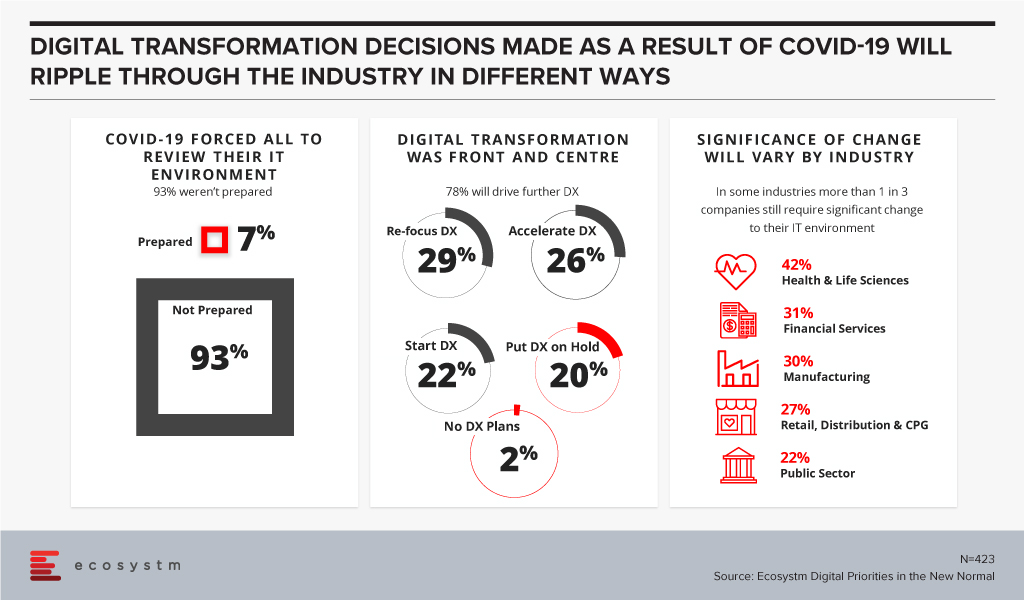

2020 has seen extreme disruption – and fast. The socio-economic impact will probably outlast the pandemic, but several industries have had to transform themselves to survive during these past months and to walk the path to recovery.
Against this backdrop, the Retail industry has been impacted early due to supply chain disruptions, measures such as lockdowns and social distancing, demand spikes in certain products (and diminished demands in others) and falling margins. Moreover, it is facing changed consumer buying behaviour. In the short-term consumers are focusing on essential retail and conservation of cash. The impact does not end there – in the medium and long term, the industry will face consumers who have acquired digital habits including buying directly from home through eCommerce platforms. They will expect a degree of digitalisation from retailers that the industry is not ready to provide at the moment. This raises the question on how they should transform to adapt to the New Normal and what could be a potential game-changer for them.
Translating Business Needs into Technology Capabilities
In his report, The Path to Retail’s New Normal, Ecosystm Principal Advisor, Kaushik Ghatak says, “Satisfying their old consumers, now set in their new ways, should be the ‘mantra’ for the retailers in order to survive in the New Normal.” To be able to do so they have to evaluate what their new business requirements are and translate them into technological requirements. Though it may sound simple, it may prove to be harder than usual to identify their evolving business requirements. This is especially difficult because even before the pandemic, the Retail industry was challenged with consumers who are becoming increasingly demanding, providing enhanced customer experience (CX), offering more choices and lowering prices. The market was already extremely competitive with large retailers fighting for market consolidation and smaller and more nimble retailers trying to carve out their niche.
In the New Normal, retailers will struggle to retain and grow their customer base. They will also have to focus aggressively on cost containment. A robust risk management process will become the new reality. But above all else, they will have to innovate – in their product range as well as in their processes. These are all areas where technology can help them. This can come in the form of technology partnerships, adopting hybrid models, increased usage of technology across all channels and investing in reskilling or upskilling the technology capabilities of employees.
Re-evaluating the Supply Chain
One of the first business operation to get disrupted by the current crisis was the supply chain. Ecosystm Principal Advisor, Alea Fairchild says, “Retailers are finding themselves at the front-end of the broken supply chain in the current situation and there is an enormous gap between suppliers and buyers. Retailers will have to aim to combine inventory with local sourcing and become agile and adopt change quickly. This will highlight to them the importance of transparency of information, traceability, and information flow of goods.”
Ecosystm research shows that supply chain optimisation and demand forecasting among the top 5 business solutions that firms in Retail consider using AI for (Figure 1).

“In the New Normal, consumers are going to demand the same level of perfection that they have received and at the same cost. In order to make that possible, at the right time and at a lower cost, automation has to be implemented to improve the supply chain process, fulfill expectations and enhance visibility,” says Ghatak. “Providing differentiated CX is intimately dependent upon an aligned, flexible and efficient supply chain. Retailers will not only need to innovate at the store (physical or online) level and offer more innovative products – they will also need to have a high level of innovation in their supply chain processes.”
Digital Transformation in the Retail Industry
Ecosystm research reveals that only about 34% of global retailers had considered themselves to be digital-ready to face the challenges of the New Normal, before the pandemic. The vast majority of them admit that they still have a long way to go.
With COVID-19, the timeframes for digitalisation have imploded for most retailers. The study to evaluate the Digital Priorities in the New Normal reveals that in Asia Pacific nearly 83% of retailers have been forced to start, accelerate or refocus their Digital Transformation (DX) initiatives (Figure 2).
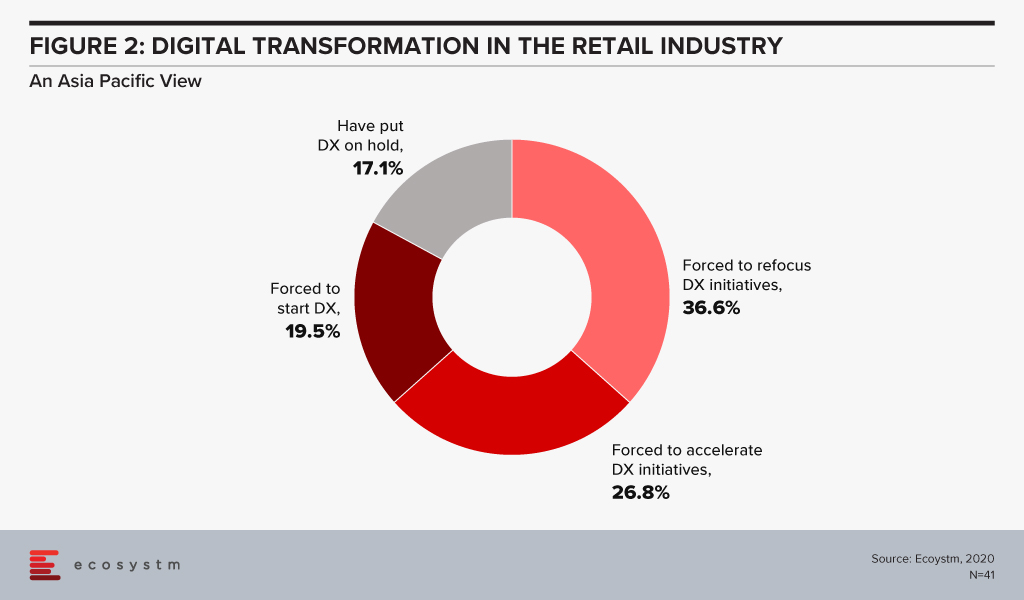
So, what technology areas will Retail see increased adoption oF?
Fairchild sees retailers adopt IoT, mobility, AI and solutions that deliver personalised experiences such as push notifications. What they are likely to do is blend different aspects of their physical and virtual environment to create a solution for customers. “To address in-store processing, hygiene, safety standards and compliance requirements, retailers will change their processes through a combination of resources, KPIs, automation, task management software and switching the information flow.”
Ghatak thinks automation has a significant role to play in improving both CX and the supply chain. “This is also an opportunity for retailers – both online and in-store – to create a solution experience where technologies such as Augment/Virtual Reality (AR/VR) can help. While retailers are adopting these technologies, with 5G rollouts, there is potential that the adoption will implode in a short time-frame.”
Those retailers that are not re-evaluating their business models and technology investments now will find themselves unprepared to handle the customer expectations when the global economy opens up.
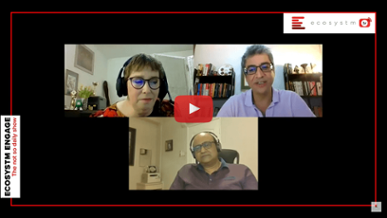
The current state of the world is alarming. The COVID-19 virus is not only disrupting businesses and economies – it is taking away loved ones, it is separating friends and families, it is disrupting the education of young adults and children and it is seeding fear in communities. But while the media is dominated with doom and gloom at the moment – and we do need these reports – I believe it is worth stopping for a moment to consider the fact that if the pandemic happened ten or fifteen years ago, many businesses – and government agencies – would have closed down. You could argue that the world wasn’t as globally connected then as it is now. And to an extent that is correct – the numbers of air travellers increased up until the end of 2019. But even in 2005, the world was still a very global place – economies relied on cross-border commerce as much then as they do now.
Depending on your business or industry 10-15 years ago:
- Staff couldn’t have effectively worked from home. And if they did, collaboration would have been hard (if not impossible outside of the usual voice services). Teleconference services would have needed to be booked.
- Remote access would have been painful and slow – relying heavily on VPNs over slower internet connections.
- Software would have mainly been running in company datacentres – with very little SaaS-based applications. These applications were often designed for LAN access…
- Those lucky few with a Blackberry or iPhone might have had access to email – everyone else would have needed to go into the office to get work done.
But worse than this would have been our customer engagements. While eCommerce had healthy adoption by 2005, it often relied on very manual processes – and it was mainly focused on consumer products and services – B2B adoption was still a number of years away. And, for many businesses, it represented a tiny proportion of their revenue. Small companies didn’t often have the web presence to compete with the big players. But if I look at the big fast-food giants in Australia (e.g. McDonalds and KFC) – these companies didn’t have a web or mobile ordering until a few years ago, and even more recently for home delivery services. Any company that had to shut down their face-to-face contact would have likely fallen back on their contact centres – but even these would have been impacted as the ability to route calls to remote or home-working call centre agents barely existed then – so they would have been understaffed or closed due to an infection being discovered…
Today’s digital connectivity has the opportunity to save lives. Less physical contact means less people being exposed to – and spreading – the virus.
If this pandemic had happened 10-15 years ago, many small AND large businesses would have had to shut their doors very quickly. Very early in the cycle, businesses would have had to make the decision to shut their doors straight away, or risk accelerating the infection rates by having staff continue to attend the office or contact centre. So if there is one small positive we can take away, it is that our digital investments are paying off very quickly. The ability to continue to trade, continue to sell, continue to do business in such a market as we are facing today and tomorrow is priceless. I can purchase goods and services online, register my car without leaving my desk, upgrade or change my health insurance without speaking to a single human being. Most businesses have the ability to have their employees access many of their critical applications wherever they are located. Our accountants can still pay and send bills, HR can hire for open positions, product teams can continue to innovate on the products and services they offer.
Don’t get me wrong – business survival is not guaranteed. This is why I implored governments to aim their stimulus spending towards small and medium businesses digital initiatives – as cafes, retailers, bars and restaurants close down across cities, states and countries, many are now lamenting their immature online presence, their lack of delivery and their lack of pre-ordering. If you have any doubt about this, check your local Facebook group – it is full of small businesses putting up images of menus in the hope that customers will reach out directly to keep their businesses running. If these businesses are given incentives to build digital services quickly, they might see less of a slowdown in business.
COVID-19 will definitely stress test our digital assets and strategies. Just recently, the Australian government’s citizen-facing portal crashed as too many citizens logged on to register for welfare. This forced many people out into government shop-fronts – putting themselves, the staff and all connected families and friends at risk of catching the virus. I also heard today of a bank that called many of its staff back to the office as the VPN could not cope with the number of users and volume of traffic! If you have not already, you will quickly find out how your digital capabilities are performing – where you need extra capacity, where services are running smoothly, where you need to rethink process design or where you need to consider re-crafting this approach for the fully digital era.
But stay safe – listen to the advice of medical experts and act on that advice. A senior medical officer recently stated that social distancing is the only way that we will overcome this virus – so stay safe and stay home (if you can!). But also take the time to review your digital capabilities – start making moves now to ensure they help your business stay afloat – or your government agency to keep serving citizens in times of restricted trading or shutdowns.
At the end of last year, Ecosystm published The Top 5 IoT Trends for 2020. Principal advisors, Kaushik Ghatak and Francisco Maroto predicted that in 2020 5G providers will be forced to operate outside their comfort zone. While the impact on network and communications equipment providers will be immense, 5G will also force telecom providers to re-think their existing business models. They may not be the best equipped to take 5G technology to market, they way the operate now.
Traditionally telecom providers have been focused on horizontal technologies and on connecting people. They have not had to have conversations around connecting machines – where every industry has their own unique use cases. This verticalisation, will force telecom providers to deal with newer stakeholders in their client organisations – not just IT infrastructure and Facilities. Several telecom providers have in the past become public cloud providers, as their markets becomes smaller and they face competition from global cloud storage providers. Now, telecom providers will increasingly look to partner with cloud providers and systems integrators with relevant industry experience, to translate the value proposition of what they are offering. “Strategic partnerships between leading technology and telecom operators are taking place especially in building various 5G use cases and applications centred on the cloud computing platform,” says Shamir Amanullah, Principal Advisor Ecosystm.
Maxis Strengthening their Market Position in Malaysia
The recently announced partnership between Maxis and Microsoft is an example of how these partnerships will pan out. Maxis does not want to be viewed only as a telecom provider and wants to be the leading Malaysia-based solutions provider. As telecom providers also start to tap the enterprise market, cloud and IoT will be key technology areas, that they should focus on.
“Maxis is leading the way as a converged solutions provider in Malaysia and following the appointment of Gökhan Ogut as the CEO in 2019, there has been a focus to grow the enterprise business which promises a lucrative opportunity,” says Amanullah.
“While the mobile connectivity market is effectively about customer retention in a saturated market, new opportunities lie in enterprise needs for fixed connectivity, managed services, cloud and IoT which is largely untapped. The expected deployment of the 5G network will spur new applications, business models and partnerships.”
Maxis’ move appears to be well-thought. Amanullah thinks that the strategic partnership with Microsoft will help Maxis accelerate its enterprise solutions offering combined IoT and 5G capabilities with Microsoft’s Azure IoT technology. It will also allow for hybrid environments, which is important given the rise of hybrid and multi-cloud adoption. Ecosystm research shows that hybrid cloud adoption in Malaysia is at a nascent 7%. But if they take a lesson from their neighbour, the rise in adoption will be steep. Our research finds that hybrid cloud adoption in Singapore is around 42%.
Telecom providers are also focusing on Digital Transformation (DX). In the Top 5 Telecommunications & Mobility Trends for 2020, Liam Gunson, Director Ecosystm says, “In 2020, operators will focus on transforming the core – remove unnecessary costs, improve customer experience, capture new opportunities – and on building telecom networks with scalability, flexibility, efficiency and agility.” Microsoft’s enterprise Modern Workplace solutions including Microsoft Teams will aid Maxis’ own DX efforts. Maxis will offer fixed line voice calls with the unified communications service.
Mutually Beneficial Partnership
Amanullah also sees this as a positive move for Microsoft. “Microsoft is poised to lead efforts in 5G network deployment which promises to enhance capabilities and drive new economic growth, especially with the focus on Industry 4.0. Maxis’ position as a leading enterprise communications provider and Microsoft’s enterprise technology experience and offerings promises a mutually beneficial partnership.”
Ecosystm research finds that Microsoft is the leading cloud provider in Malaysia when it comes to brand perception, and about a third of enterprise cloud deployments use Microsoft. Amanullah thinks that, “Microsoft’s leading position in cloud platforms is an attractive proposition for enterprises that are looking at speed, performance, reliability, global scale, security and lower costs.”
Talking about the 5G applications that the Malaysia market will see, Amanullah sees tremendous business opportunities in areas such as smart city, autonomous driving, smart traffic management, virtual reality (VR), augmented reality (AR), cloud gaming, and healthcare, to name a few.
As the ‘Experience Economy’ becomes a reality, organisations will look beyond improving customer experience (CX) to enhancing employee experience (EX). It is estimated that people spend a third of their life at their workplaces. This realisation will drive organisations to focus on EX over priorities such as growing revenue or reducing costs. Retaining employees is important in today’s war for talent – and organisations have started appointing Chief Experience Officers. Ultimately, workplace technology should drive employee productivity – and there is a proven link between happy and productive employees.
The Top 5 Workplace Of The Future Trends For 2020
The Top 5 Workplace of the Future trends are drawn from the findings of the global Ecosystm CX Study and are also based on qualitative research by Ecosystm Principal Advisors, Tim Sheedy and Audrey William.
-
Employee Experience as a Business Focus Will Drive Faster Adoption of Consumer Collaboration Tools
Organisations in mature economies already have employee experience (EX) and CX as their top business priorities. This comes with an understanding that offering a great customer and employee experience will lead to revenue growth, profit growth and lower costs.
For communication and collaboration solutions, if the experience is not right, employees will move on to the next best app for the right experience. The competition between the vendors across voice, video and collaboration is heightening. It may sound simple but that is where the innovation needs to happen in the industry. If employees do not like what IT has provided for them, they will download the application of their choice for work. This will be a huge challenge especially in industries that are heavily regulated such as Financial Services and Healthcare.
-
HR KPIs Will Drive IT Teams to Invest in Workplace Analytics
HR teams are ultimately responsible for driving improved EX. And a happy employee is a productive employee – so an employee’s environment (managed by the Operations or Facilities team) and their technology (managed by the IT team) will have the biggest impact on driving employee satisfaction. To drive these outcomes, we will see these three teams work closer than they ever have – and not just on a project basis, but as a permanent arrangement.
Investments in Workplace Analytics will increase, and there will be more collaboration between IT, HR and Facilities Management to drive best practices for employees. Right now, there is very little collaboration between the three departments in driving better workplace practices. Workplace Analytics will help solve problems related to poor office practices around email overload, long work hours, absenteeism, usage of rooms and other facilities, employee discontent, as well as understand the overall trends on communications and collaboration solutions usage.
-
5G Services will Push Organisations to Rethink their Network
Today 5G is not available in many countries – and where it is available coverage is generally spotty. But this will change in 2020 as more operators launch or expand their 5G coverage. The unique capabilities of 5G to offer software-defined networks (SDNs) – designed specifically for organisations’ needs – will help businesses rethink the way they operate. They can stop thinking of their network as a physical place and start thinking of it as a set of capabilities and this takes work beyond designated physical addresses. Retailers will be able to offer complete retail environments from wherever they choose. Banks will be able to offer complete in-branch services from anywhere. Employees will be able to get access to all sorts of data and systems regardless of location. 5G is about much more than a faster network – the potential to transform enterprise networks will see a huge rethink of the network and the way IT teams provide technology services to their employees.
-
Organisations Will Wake Up to the Need for the Right Knowledge Management Solution
IT has been guilty of dictating the knowledge management (KM) requirements and platforms to the business. Many customer teams are using tools that are inherently wrong for the job. Management is using tools that do not support their needs, and information workers are given generic platforms when they have specific needs. 2020 will see a fragmentation of the KM market as businesses start to buy based on customer and employee needs – not based on what the IT team dictates.
-
2020 Will See a Rise in CPaaS Adoption
Cloud-based platforms that enable developers to add real-time communications features within the workflow of their own business applications will be the next big area of innovation in the unified communications space. Through the use of APIs, developers can embed communication capabilities into their existing business applications, without extra hardware or software costs. Developers can embed it directly into the cloud platform so the time to market is fast. Communications Platform as a Service (CPaaS) will see greater adoption as more organisations look to build code and apply agile and DevOps methodologies.
Download Report: The top 5 Workplace of the future trends for 2020
The full findings and implications of the report ‘Ecosystm Predicts: The Top 5 Workplace of the future Trends for 2020’ are available for download from the Ecosystm platform. Signup for Free to download the report and gain insight into ‘the top 5 Workplace of the future trends for 2020’, implications for tech buyers, implications for tech vendors, insights, and more resources. Download Link Below ?

As a technology analyst I have followed HCL for many years – and their capabilities have changed over that time – particularly in Australia and New Zealand. When they entered the ANZ market they were somewhat unique – an Indian IT Service provider with views and opinions. One who was not just good at meeting RFP requirements and delivering technology projects, but also individuals who were empowered to challenge the status quo in their clients – to challenge clients to be better. But as several large managed services providers lost their way in ANZ, HCL stepped in and – for a number of years – became all about outsourcing and managed services. They grew their business significantly, but what seemed to be lost was that factor that set them apart. In focusing on good delivery they seemed to lose their differentiator.
However, I recently spent a few days with HCL and their clients in Adelaide and I can report that they are back. They are winning digital transformation deals. They are driving a technology industry agenda and are becoming an important force in the education and evolution of the high tech sector in Australia and New Zealand. Adelaide was chosen for the event as HCL wanted to showcase how they are making real investments in the local market, and how they are helping South Australia to transform itself and create new job opportunities both in Adelaide and in the regions. Their managed services contract with Elders is a great starting point for them – and in meeting and interviewing the Elders stakeholders, it is clear that it is a partnership – HCL has collocated to ensure that the HCL staff are side-by-side with the Elders teams – and they are doing a good job in driving innovation into the Elders business.
The Cricket Australia digital transformation contract is a big deal, and is really a great indicator of their capabilities. HCL won the contract from Accenture – showing that they can compete against and beat the best (Accenture is the biggest IT services provider in Australia today – and for good reason). Building off their success with Manchester United, HCL has won another important digital transformation deal with a global sporting brand. Personally, as a fan of the Australian women’s and men’s cricket team, I look forward to engaging with the fruits of their endeavours soon!
The main take away from the time spent with HCL is that they are growing their business here in Australia and across the entire Asia Pacific region – and that the growth is coming from many areas – not just traditional outsourcing contracts but also across the spectrum of digital transformation. Importantly they are also taking responsibility for that growth – bringing the market along with them as they look to help educate and employ the next generation of technology professionals.
HCL also seem to have mastered the ability to both respond to the standardised processes of the sourcing deal advisors as well as stand out as an individual company. While deal advisors play an important role, I often hear clients say that they can sometimes take the personality out of a deal. They bring comparisons between vendors to standard and measurable metrics – but you sign a deal with a person, you negotiate with a person, and it is people who deliver the solution. Winning deals is not just about proving the ability to deliver, but also convincing the client that they want or need to partner with the IT services business. Based on client feedback, HCL is mastering both sides of this process, and are earning the right to be considered in a broader range of deals.
If you are dealing with HCL, it may also warrant looking beyond the traditional measurable metrics. Speak to their leadership team both locally and globally, especially given their emphasis to bring in local leadership in their key markets . Get a feel for the culture of the company and whether or not it matches your culture or even sometimes challenges your business to be better. Services deals are ultimately about people, so spend time with the people – challenge them to come to the party. Put them under stress and see how they respond, as it is typically the hard times that define the longer term success of a partnership.
While talking about the paradigm shift that we are seeing in the industry today, I like to use the analogy of space exploration. The aim is to make space an extension of the earth through its use in communication, tourism and for mineral exploration. This is an entirely new paradigm on how all the investments in space technology and transportation are being made – by private industries as well as by governments of major economies.
Similarly, technology is no longer a business enabler – it is now a catalyst to create and capture new value streams and to create sustainable differentiation. The relationship between customers and enterprises is now a two-way street. Customers are not just using products and services but feeding information and critical insights back to the enterprises on a real-time basis. Now, even B2B enterprise businesses must be seen more as a B2B2C.
This new paradigm has brought technology to the core of every business and is forcing enterprises to transform the way they run their businesses.
The Multiplier Effect
Enterprises have to look at technology with a fresh new lens now. So far, they have had to cope with any emerging technology in isolation. Now they are being hit by a number of technologies – agile network, cloud, data analytics, intelligent technologies – each of which has its impact. But what makes it transformational is the interplay of these technologies. Big Data analytics, AI and IoT has taken in isolation can definitely impact an organisation. But when the three work together, they have an exponential impact on an organisation and on it’s Digital Transformation (DX) journey. This has two clear impacts on businesses.
Impact on Enterprises
Expanding Role of Business Functions. As organisations embark on their DX journeys, they are likely to increase technology spend. Even though some budget would go into upgradation of IT infrastructure, a larger portion of the budget is likely to go towards digitisation, business applications, cybersecurity, and intelligent technologies. These projects would require the involvement of multiple stakeholders. And consequently, a higher proportion of technology spend will be controlled by the business functions – and this proportion will only get. Let us take AI as an instance. The global Ecosystm AI Study shows that only about a fifth of AI projects now are being funded by IT. Multiple other stakeholders are involved in emerging technology projects – the key department being where the solutions are being deployed.
Building a Transformation Roadmap. Ad-hoc implementation of technology will no longer be a viable option. What enterprises will need is an interdisciplinary model of work to attain the most value out of their transformation through technology. This should lead to a clear roadmap – that melds technological capabilities with business requirements. And mind you, each organisation’s roadmap will be distinct and unique.
Wider organisational functions will have to be engaged and aligned. Managing budgets and new business models simultaneously comes with a set of its own complexities. In my opinion, a Balanced Scorecard and Lean Approach is the way ahead for organisations as they approach Transformation.
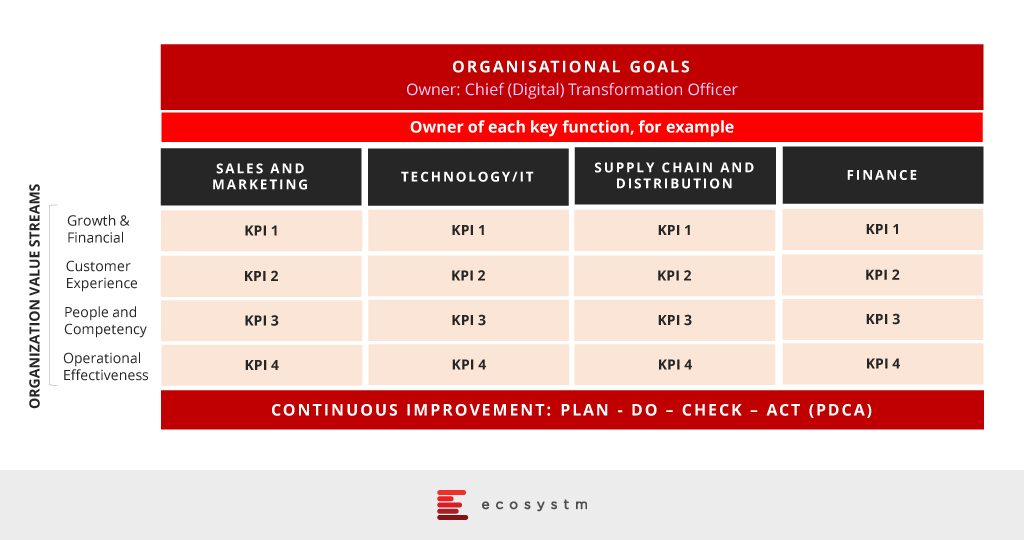
Irrespective of the size of your organisation, you have to focus on the three main building blocks necessary to implement transformation:
- Defining measurable business objectives that are aligned with the organisational goals and aspirations
- Assigning transformation owners for each of the key functions identified for Transformation
- Using structured program management using Lean principle and the Balanced Score Card approach
Understandably, an interdisciplinary model of work and a structured program may not be easy to implement. I discuss the complexities of introducing the new wave of technology in my report.
If your organisation is embarking on a DX journey or if you wish to discuss your ongoing DX roadmap, leave a comment below or connect with me on the Ecosystm platform.




